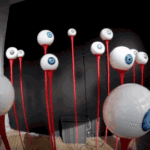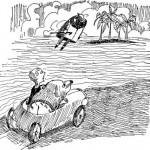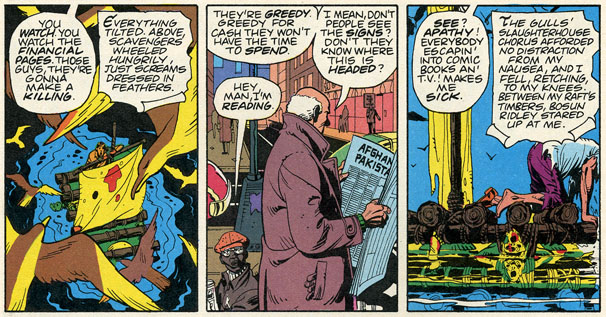No worries, I will not be performing a blog post within a blog post today. How would that even work?
Building a better story doesn’t require you working in the story itself. Sometimes, the universe around your narrative can offer all sorts of opportunities for greater scope and better engagement.
Of the three artifact types, I believe that narrative-parallel artifacts are the most common. They’re easy to create and deploy and they are the closest transmedia storytelling comes to easy franchising of a narrative. That is not to say that a well crafted narrative-parallel artifact is easy to create, the best are complex and deep narratives in and of themselves and used by prestigious authors, including Shakespeare.
A narrative-parallel artifact is narrative fragment that runs external to your main narrative but still relates to it. It can be accessible to your characters, but does not have to be in their reach. Essentially it is an artifact that runs parallel to your main narrative thread.
Why use narrative-parallel artifacts?
This specific type of artifact comes with a host of advantages for creators. It allows you to influence the readers’ perception without forcing characters into obvious foreshadowing, authors can create implications and pass judgement calls outside of the main narrative and without disrupting the reliability of the narrative voice.
Parallel artifacts also allow you to build a world around your narrative without forcing excessive exposition on your readers. It can also work to construct and reinforce a certain mood within a narrative.
Where have narrative-parallel artifacts been used?
Once again, I’ve assembled a list of both general and specific narrative-parallel artifacts in action to provide context.
Video games
There are a number of different implementations of narrative-parallel artifacts in video games. The two most common are in-game TV and book chapters.
Two prominent examples of effective in-game video use are Max Payne and Alan Wake. Here are two videos:
The first is from Max Payne. This is one of two compilations of one of the in-game TV shows that played on televisions left on throughout the game. The player could walk right past them, skipping most of the content, or choose to stay and watch them play out over a brief period. You can watch the first few minutes show two different executions of the technique.
[youtube]http://www.youtube.com/watch?v=DHF8YlByLnE[/youtube]
The second video is from Alan Wake, where most of the TVs in the game play a very short episode of Night Springs, a story based on the inspirations for the game, Twin Peaks and The Twilight Zone. Players interacted with these videos in much the same way.
[youtube]http://www.youtube.com/watch?v=f6V0R2VFytE[/youtube]
In Max Payne the videos sometimes foreshadows symbols or narrative elements that will appear later. Sometimes the videos just help set the creepy and sort of over the top mood. For Alan Wake, the videos provide all that and, sometimes, explain some of the more complex underlying concepts of the narrative.
The other narrative-parallel artifacts frequently found in video games are books. The best executed in-narrative books are found in Deus Ex. They both compounded emotion during the game and create greater depth. Sometimes they act as foreshadowing and at other times they provide background information for the narrative. In either case, they are also optional.
Comics
I could probably find a number of examples within comics, which are famously self-referencing and recursive. However, I’ll start and stop with the most prominent.
Watchmen uses many narrative artifacts between its two covers. In fact I could probably write a post just on Watchmen‘s artifact use. The most prominent and persistent of these artifacts is The Black Freighter. A comic within the narrative that provides subtext and depth to Alan Moore’s world, one that lacks morals and ethical direction. Moore used the horrifying text of The Black Freighter to help illustrate the apparent hopeless, heartless and self-destructive world of his characters. As revelations unfolded within the story, parallel revelations were occurring for and around the main characters.
In fact, the series of asides which contained The Black Freighter, independent from the characters, could be considered an artifact itself. The asides placed between chapters are also a form of narrative-parallel artifact.
Journalism
In journalism the most common implementation of narrative-parallel artifacts is the sidebar. I’m referring to a box to the side or otherwise separated from the story that contains information relevant to understanding the story, but not necessarily in the story.
In TV journalism the lower-third is a common location for narrative-parallel content.
Shakespeare
While there are earlier appearances of the story within a story, the most popular in modern culture is Hamlet. The Danish prince crafts his own play within Shakespeare’s play, creating a narrative-parallel artifact that illuminates the character’s thinking and provides a significant plot point.
This blog
While I’ve done the occasional sidebar, I’d have to say that my most common usage of narrative-parallel artifacts is in the pink-highlight asides that are throughout my posts.
Besides allowing me to address you in a different voice than use in most of my posts, the tooltips create opportunities for additive, but not required, information that can help you expand your understanding or find a chuckle.
Building your universe with narrative-parallel artifacts
The best place to start is to understand that your narrative does not live in isolation. Even if it just fell out of your head on to a piece of paper this very moment your story has background, context, a past and a future. If you can gain a better grasp on the universe of your narrative you’ll find opportunities for narrative-parallel artifacts will pop up frequently.
This is especially useful the more interactive your medium is. Narrative-parallel artifacts thrive on giving your participants a choice, so that they can take part in the slow construction of your universe.
Later: Narrative-additive artifacts.
Before: Building structures inside of your story with narrative-centric artifacts.
Related articles
- The Game Narrative Triangle [Design] (kotaku.com)
- Building structures inside of your story [Narrative Artifacts: 2 of 4] (hacktext.com)
- Artifacts: building dimension into your narrative [Narrative Artifacts: 1 of 4] (hacktext.com)
- What is a text and how do I hack it? (hacktext.com)
- Let’s Discuss Alan Wake Episode Two – Now [Game Club] (kotaku.com)
































[…] This post was mentioned on Twitter by Aram Zucker-Scharff, Jojo Pasion Malig. Jojo Pasion Malig said: RT @Chronotope: The third post in my series investigating narrative artifacts and their use in media – http://aramzs.me/2d […]